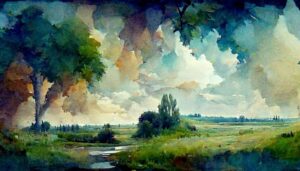
The image of a lonesome tree often embodies a moment of quiet pause, frozen in time through delicate brushwork. Watercolor as a medium lends itself perfectly to portraying the gentle stillness found in nature. Its transparent layers and subtle gradients allow artists to express softness and silence in ways other media cannot. Understanding how watercolor painters bring such calmness to life reveals much about the relationship between technique and emotion.
The Unique Qualities of Watercolor for Stillness
Watercolor’s translucency offers a softness that invites contemplation. The gentle bleed of colors and the merging of tones create a sense of atmosphere rather than harsh detail. This fluidity enables artists to suggest the quiet presence of natural elements, including trees, water, and sky.
The medium’s unpredictability can mimic nature’s organic qualities. Instead of rigid lines, watercolor embraces lightness and impermanence. These characteristics help evoke the sensation of stillness—not through precision, but through mood.
Simplification and Space in Composition
Portraying stillness requires more than technique; it depends on how the scene is composed. Artists often reduce elements to their simplest forms. The lonesome tree, isolated against an open background, draws focus while emphasizing quiet.
Empty or negative space plays a vital role here. Surrounding the tree with large expanses of unpainted paper or soft washes highlights its solitude. This visual breathing room lets the viewer’s eye rest, contributing to the overall feeling of calm.
Layering and Soft Edges to Suggest Calmness
Watercolor artists use layering to build depth without losing delicacy. Thin glazes of paint applied gradually create a gentle texture that feels alive yet tranquil. Soft edges—achieved by wet-on-wet techniques—blend forms into one another, suggesting gentle air and stillness.
This method contrasts with sharp, defined lines which might introduce tension or movement. Instead, soft edges allow natural transitions, replicating how light interacts with the environment in quiet moments.
The Role of Light and Shadow
Light is crucial in setting a peaceful mood. Subtle shifts between light and shadow give form to the tree and surrounding space without overwhelming the senses. Artists often choose muted palettes with cool or warm tones to reflect early morning or late afternoon calmness.
The way shadows fall around the lonesome tree can suggest time slowing down. Long, gentle shadows stretch across a field or softly frame the tree’s trunk, inviting viewers to experience that stillness for themselves.
Expressing Emotion Through Minimal Detail
The emotional power of a watercolor painting lies in what is left unsaid. By avoiding over-detailing, artists allow imagination and feeling to fill the gaps. The lonesome tree becomes more than an object—it transforms into a symbol of solitude, peace, or reflection.
This minimalism challenges viewers to engage personally with the scene. The quiet presence of the tree offers a moment of introspection, a chance to connect with nature’s calmness even through a simple image.
Techniques for Maintaining Control and Spontaneity
Watercolor requires a balance between control and letting go. Artists carefully plan areas of focus, such as the tree’s silhouette, while allowing other parts to flow freely. This tension mirrors nature itself, where stillness exists alongside subtle movement.
Using dry brushwork, lifting paint to create highlights, and controlled washes helps maintain clarity. At the same time, embracing the medium’s fluid nature results in soft, unpredictable textures that enhance the feeling of natural stillness.
The Dynamic Nature of Water
Rivers are living, moving bodies of water. This constant motion creates patterns of light, shadow, and color that change by the moment. Watercolor, with its fluidity and transparency, can mimic these shifts naturally. The way pigment spreads and blends on paper mirrors the flow of water over rocks and around bends.
Artists find inspiration in how water interacts with its surroundings. Ripples, reflections, and the transparency of shallow pools come to life through layered washes and soft edges. This makes rivers perfect subjects for water-based media, where capturing movement and mood is key.
Contrast Between Movement and Calm
River settings in artwork often balance two opposing sensations: the river’s flow and the stillness of its banks. This contrast adds emotional depth. The swift current suggests energy and change, while the surrounding trees, rocks, and sky convey peace and permanence.
Watercolor artists highlight this tension by combining vibrant, dynamic brushstrokes for water with softer, muted tones for the landscape. The interplay invites viewers to experience both excitement and tranquility in a single scene.
Conclusion
Capturing stillness with watercolors is an art of restraint and sensitivity. The image of a lonesome tree stands as a quiet witness to nature’s peaceful moments, brought to life by soft washes, thoughtful composition, and subtle light. Through these techniques, artists create works that invite calm reflection and allow viewers to experience a serene pause. This delicate balance between control and spontaneity makes watercolor uniquely suited to portraying the gentle stillness found in the natural world.